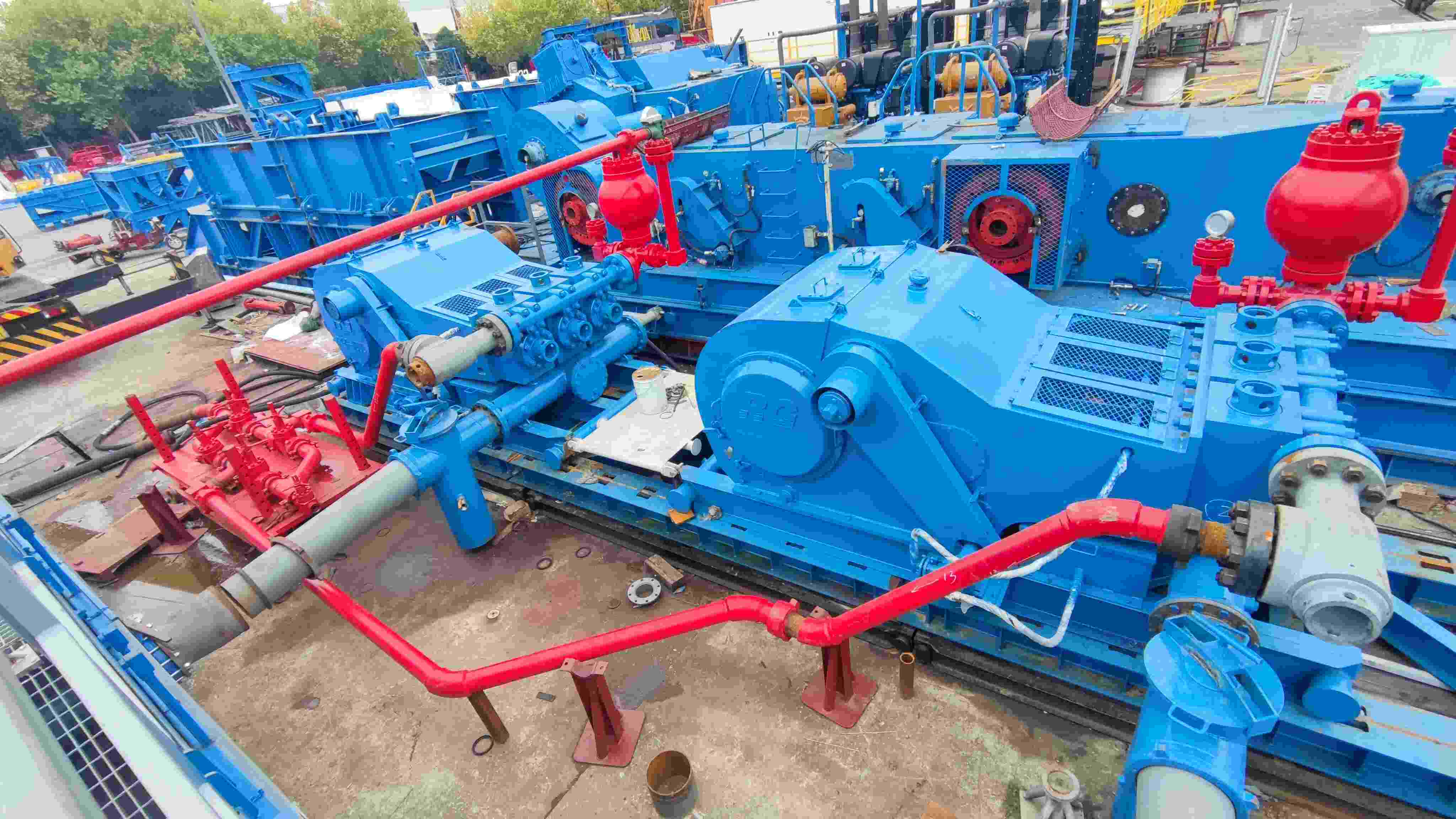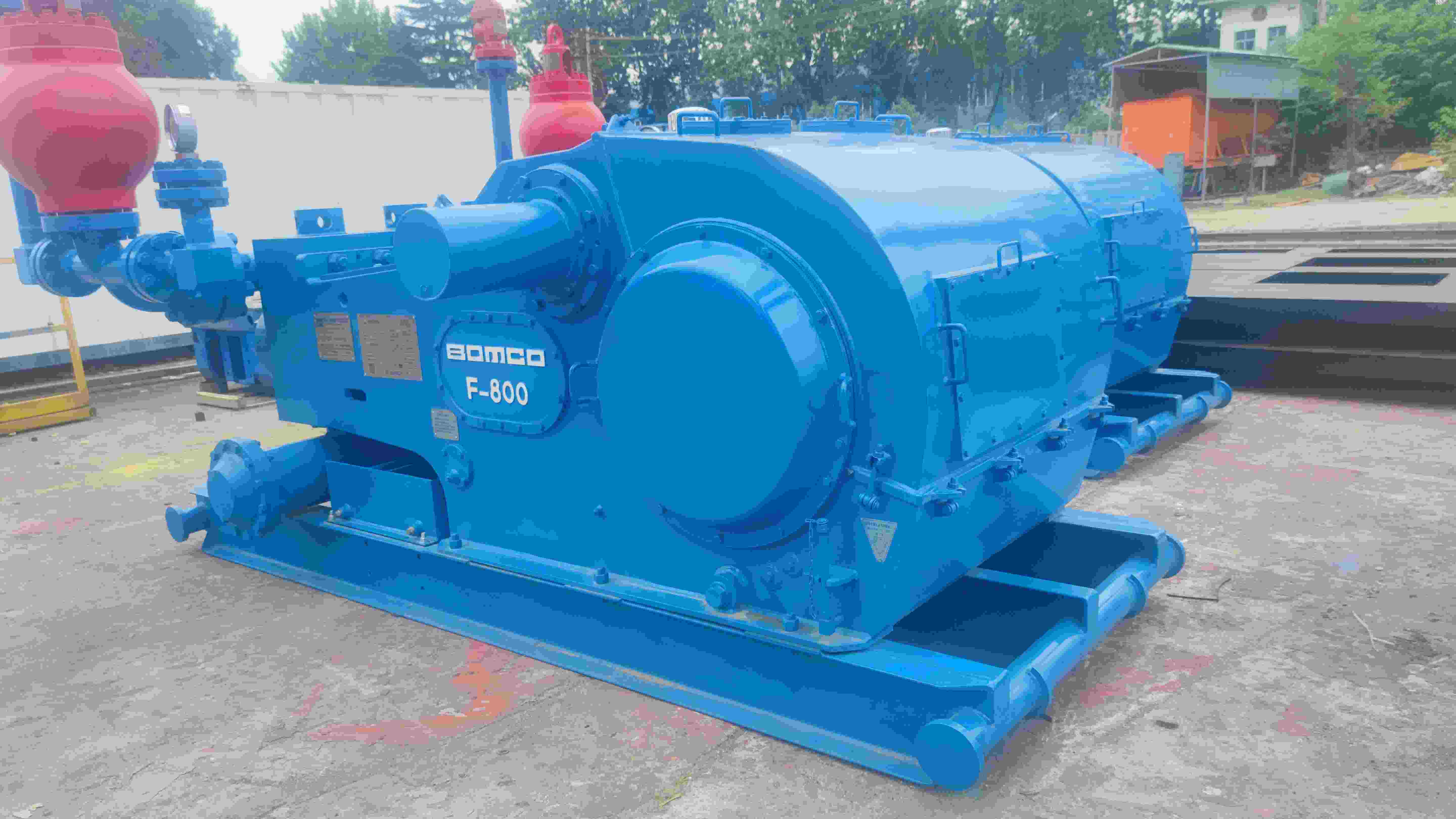Exploring the F-Type Drilling Mud Pump: The Powerful Engine for Underground Engineering
Dec 25, 2024
The F-type drilling mud pump is an essential piece of equipment in oil extraction. It is a prevalent reciprocating plunger pump and a key device for outputting mud as part of the rig's auxiliary equipment. This pump can inject the mud from the mud pit into the wellbore under high pressure, which serves to cool and safeguard the drilling tools and bits, stabilize the well wall, and bring the drilled cuttings back to the surface. Mastering the know-how of selection, installation, operation, and maintenance is of great significance for every user. Next, let's get to know this mud pump from its structural design, working principle, performance advantages, and routine maintenance, so as to pick the most suitable one
I. Structural Design
The F-type drilling mud pump mainly comprises two major parts: the power end and the fluid end.
1.Power End Components
Frame: The frame functions as the fundamental structure that supports and secures all components of the mud pump. It endures the weight and vibration forces of the entire pump
Crankshaft: Linking the pump body to the power source, the crankshaft transmits power to the connecting rod and the pump body via rotational motion. Made primarily of high-quality carbon steel, it benefits from the material's high strength and excellent wear resistance, enabling it to withstand the vibration loads during the pump's operation and ensure its stable running.
Connecting Rod: This component bridges the crankshaft and the pump body. It transforms the rotational motion of the crankshaft into reciprocating motion, driving the pistons in the pump body to move up and down.
Crosshead: Positioned at the inlet end of the mud pump, the crosshead acts as the connection interface between the pump body and the inlet and outlet pipelines.
Guide Plate: Situated at the discharge port of the pump body, the guide plate is used for regulating and controlling the flow direction and rate of the mud, guiding it to flow smoothly to the subsequent system or equipment.
2.Fluid End Components
Nozzle: Located at the outlet of the pump body, the nozzle is responsible for ejecting the mud out of the pump.
Inlet and Outlet Pipelines: These pipelines connect the pump body to the drilling system, facilitating the entry and exit of the mud.
Valves: Valves are employed to control the flow of the mud. Common valve types include inlet valves, outlet valves, and pump body valves.
Impeller: As the core element of the fluid end, the impeller converts the power from the electric motor or diesel engine into the pressure energy of the liquid.
II. Working Principle
Suction Phase: Power is output from the rear diesel engine, transmitted through the reduction gearbox and universal shaft to the chain box, and then distributed to the input shaft end of the mud pump. The mud pump drives the main shaft and crank to rotate via transmission components like belts, crosshead universal shafts, and gears. As the crank moves reciprocally, the mud is drawn into the pump cylinder. The suction valve opens, and the piston moves to the right, completing the mud suction.
Discharge Phase: With the continuous rotation of the crank, the piston starts to shift towards the hydraulic end assembly. The mud in the pump cylinder gets compressed, causing the pressure to rise and the suction valve to close. Once the safety valve reaches the preset pressure, it opens, allowing the liquid to flow into the discharge pipe. As the piston continues to move leftward, the mud is pumped through the discharge pipeline to the bottom of the well under pressure, thus completing the liquid circulation.
It should be noted that:
The F-type drilling mud pump is usually used in tandem with a solid control system to filter solid particles and cuttings, maintaining the purity of the mud.
The rotational speed and flow rate of the mud pump can be adjusted according to specific drilling requirements.
During operation, it is necessary to constantly monitor the pump's operating parameters, such as pressure, flow rate, and temperature, to guarantee its normal function.
Regular maintenance, including lubricating oil replacement, seal inspection, and pump body cleaning, must be carried out to uphold the pump's performance and lifespan.
III. Performance Advantages
High Pressure and High Flow: The F-type drilling mud pump generally can supply relatively high pressure and flow rates, meeting the demanding needs of the drilling process.
Good Corrosion Resistance: Given that drilling fluids often contain various chemicals with corrosive properties, the F-type mud pump is typically fabricated from materials resistant to acid and alkali corrosion. This feature effectively withstands the corrosive effects of the drilling fluid and prolongs the equipment's service life.
Sturdy and Reliable Structure: Adopting a heavy-duty steel structure, the F-type mud pump has high strength and rigidity, ensuring its durability under harsh working conditions.
User-Friendly Operation: It is relatively straightforward to operate, and the equipment's commissioning, maintenance, and repair are convenient, reducing the technical threshold for operators.
Versatility: This type of mud pump can be applied not only to the mud circulation system but also to other scenarios like grouting and water pumping, expanding its usability.
Three-Cylinder Design: The F-series mud pumps usually feature a three-cylinder design. The coordinated work of the three pistons generates a smooth and continuous flow of drilling mud, enhancing the stability of the mud supply.
Typically, the F-type drilling mud pump comes in models ranging from F500 to F2200. When choosing a model, we need to consider their specific performances:
F500 Drilling Mud Pump: With a rated power of 373 kW, it has a relatively small maximum displacement, making it suitable for shallower drilling depths. It is compact in size, lightweight, and easy to move and install, often used in small-scale drilling projects or as a standby pump.
F800 Drilling Mud Pump: Having a rated power of 596 kW, it offers a larger displacement and higher pressure compared to the F500. It is applicable to medium-depth wells and wellheads of moderate diameter, commonly used in conventional oil and gas drilling projects.
F1000 Drilling Mud Pump: Rated at 746 kW, it has an even larger displacement and higher working pressure, suitable for deeper wells and larger-diameter wellheads, typically used in large-scale oil and gas drilling operations.
F1300 and F1600 Drilling Mud Pumps: The F1300 has a rated power of 969 kW, and the F1600 has 1193 kW. These two models are suitable for high-intensity construction in deep and ultra-deep wells, with larger displacements and higher working pressures to meet more complex drilling demands.
F2200 Drilling Mud Pump: With a rated power of 1640 kW, it boasts the largest displacement and working pressure, appropriate for special large-scale drilling projects, especially those involving ultra-deep wells, high well pressures, and complex geological conditions.
When selecting a model, the following factors also merit consideration:
Drilling Depth and Wellhead Diameter: Select a mud pump that aligns with the target drilling depth and wellhead diameter.
Drilling Environment and Geological Conditions: Based on the specific drilling environment, geological situation, and working condition requirements, choose an appropriate mud pump model.
Working Pressure and Flow Rate Requirements: Determine the required working pressure and flow rate range according to project needs, and then pick a suitable mud pump model.
Equipment Quality and Reliability: Opt for well-known brands with reliable quality and convenient maintenance.
IV. Daily Maintenance and Installation Preparation
Maintenance Management
Strengthen maintenance management to ensure the equipment's safe and stable operation.
Designate specialized personnel to handle daily maintenance and repair tasks, and keep spare parts fully stocked.
Regularly inspect and maintain all components, resolving issues promptly to minimize losses.
Clean the oil sump and replenish new oil regularly.
Installation Preparation
Select a solid, flat site. Ensure that the installation foundation is firm, level, and has sufficient load-bearing capacity. Anchor bolts should be tightened strictly in accordance with the specifications, and shock-absorbing gaskets can be added if necessary to reduce vibration and noise during operation.
Check the specifications, models, and quantities of the mud pump and related equipment to ensure they meet the drilling design requirements.
Inspect the mud pump for any damage during transportation and repair or replace it in a timely manner if found.
Installation Process
Install in line with the equipment installation drawings and relevant standards, ensuring that all components are correctly installed and firmly connected.
Connect the pipelines. The diameter and material of the suction pipe and the discharge pipe should match the pump's design parameters. Keep the pipelines unobstructed to prevent blockages in the mud flow.
During installation, pay attention to the proper positioning and adjustment of the mud pump to enable normal operation.
Pre-Start Inspection
Check whether all operation switches, instruments, and protection devices of the equipment are functioning normally. Examine the tightness of bolts on each connecting part and tighten any loose ones immediately.
Inspect the lubrication system, checking the level and quality of the lubricating oil. Replenish or replace it if it is insufficient or deteriorated to ensure smooth lubrication.
Clean the suction and discharge systems to rule out any blockages.
Check the power system to confirm that the connections and wiring of the motor or engine are in good order.
Starting Process
First, fill the mud pump and pipeline system with mud to avoid dry running and dry friction.
Start the mud pump slowly, observing its running state closely to ensure there are no abnormal noises, vibrations, or leaks.
Monitoring During Operation
Continuously monitor operating parameters such as the pump's outlet pressure, inlet pressure, and rotational speed.
Regularly check the sound and vibration of the pump. If any abnormalities are detected, address them promptly.
Keep an eye on whether there is any leakage in the mud pump and repair leak points in a timely manner.
Shutdown and Maintenance
Before shutting down, gradually reduce the pump's rotational speed and pressure, and close the relevant valves.
Cut off the power source to ensure the pump stops completely.
Empty and clean the mud pump and pipelines to remove residues, and carry out regular maintenance.
Read More





 Language :
Language : English
English Русский
Русский عربي
عربي
 GET A QUOTE
GET A QUOTE




 IPv6 network supported
IPv6 network supported